Moj ZET App Finally Drags Zagreb Public Transport into 21st Century
May the 29th, 2023 - A big change has finally been brought in when it comes to the Zagreb public transport network, and the launch of the long awaited Moj ZET app (My ZET) has dragged the ticket purchasing process into the 21st century.
As Poslovni Dnevnik writes, have you recently noticed the stickers placed in Zagreb's public transport vehicles? The new QR codes on the doors of buses and trams didn't end up being stuck there by accident, and it was actually the sign that the official Moj ZET app was finally on its way to passengers who had until now had to purchase tickets either on board or at iNovine or Tisak kiosks. The new Moj ZET app was officially presented today.
It was tested out by Vecernji list journalists, and here's what passengers using public transport in the capital will be able to do with the Moj ZET app as of today.
To get started, the application must be downloaded for free from the Google Playstore (Android) or the App Store (iOS). For easier use of the application, it's necessary to enable the application to use the location. The location-based app offers tickets that can be purchased in the area where the traveller is currently located.
In order to receive warnings about the imminent expiration of an active ticket, the Moj ZET application must be enabled to send the phone notifications. In addition to that, the application is available in both Croatian and English. In addition to buying tickets, traffic notifications about traffic diversions, ongoing works, temporary issues and other changes can be checked in the application.
After downloading the Moj ZET app, and in order to buy an individual ticket for use in a ZET vehicle, you'll need to top up your eWallet funds with a top up of at least one euro, while the maximum amount you can have on your account at anyone one time is 50 euros.
The new Moj ZET application will display all available maps for the area you're in on the screen (so again, turn your location on!). Selecting the desired map starts the process of reading the QR code. If a controller wants to make sure you've purchased and hold a valid ticket at the time of your travel, go to the Maps menu, in the upper left corner, and select the controller icon. A QR code will be displayed on the screen, which the controller will then read and verify with his device.
For more, check out our news section.
When Will We be Able to Purchase ZET Tickets via Mobile App?
January the 4th, 2023 - If you've ever used Zagreb's iconic (and usually blue) public transport, you'll have wondered just when it will catch up and allow people to purchase ZET tickets via mobile application (app) instead of at iNovine, Tisak, or on board the tram. It seems that we've finally got some good news on that front for 2023.
With the digital transformation seeping into just about every corner of everyday life, the green transition isn't far behind it. Tram travel is and always has been a very environmentally friendly transport option, and something the City of Zagreb does very well in, ferrying countless people around the capital day in, day out. Now the digital age might finally be catching up with it.
As Poslovni Dnevnik writes, over the first half of this year, the activation of the brand new ZET mobile application, which has been awaited and being announced for several years now, is finally expected. The new ZET administration also announced that, in addition to being able to purchase ZET tickets through the new app, it will also be possible to check the tram and bus timetables, as well as the traffic situation in the city, according to a report from Vecernji list.
By the way, it's also worth noting that the up and coming ZET application is something that has been being waited on for many years now, but so far there have been no serious developments, at least not from this Zagreb city-based company. Buying ZET tickets online is something most would more than reasonably be expecting to be able to do by now, and it's nice to see that the powers that be within Zagreb's public transport are making it a reality.
It doesn't stop there, as addition to the new ZET application, we residents of Zagreb should also soon receive a renewed fleet, which will include twenty brand new buses and the same number of new trams.
For more, check out our dedicated news section.
Overhaul for Zagreb Public Transport as ZET to Modernise Fleet
December the 3rd, 2022 - An overhaul is on the cards for Zagreb public transport as ZET plans to modernise its fleet as part of a wider project aimed at decarbonisation.
As Poslovni Dnevnik writes, as part of the JIVE2 project, organised by the national coordinating body of the Croatian Hydrogen Association and the project partner, the Hydrocarbons Agency, the final event of the demonstration CEE bus roadshow was held recently in Zagreb's popular Nikola Tesla Technical Museum, which covers three geographical areas of the EU (Central and Eastern Europe, Poland - the Baltic region and Southeastern Europe).
This is part of an important EC (Clean Hydrogen Partnership) project, which aims to encourage the commercialisation of hydrogen-powered buses, i.e. the procurement of 300 hydrogen-powered buses in accordance with the European Strategy for Sustainable Mobility and the European Hydrogen Strategy, and which is financed by the Clean Hydrogen Partnership with the support of Hydrogen Europe. The manager of the project is H2LV - the Latvian Association for Hydrogen, while the technical partners in the project are the Messer Group and CaetanoBus.
Through the JIVE2 CEE bus roadshow project, the City of Zagreb and ZET d.o.o., they got the opportunity to test these technologies in real driving conditions, collect a large amount of data (telemetry), all with the aim of making future informed decisions regarding the modernisation of the Zagreb public transport offer, more precisely the ZET bus fleet.
The president of the Croatian Hydrogen Association, prof. emer. Frano Barbir, Ph.D., said that the transition of the vehicle fleet of public carriers across Europe from the existing fossil fuel-powered drive to clean energy sources such as hydrogen is still in its infancy, and he highlighted the lack of infrastructure that would support hydrogen-powered vehicles as the main problem.
Hydrogen, as an energy carrier, has great potential for decarbonising numerous sectors of the economy, especially where batteries aren't technically possible or end up being a more expensive solution. One of these sectors is the public city transport sector where hydrogen, used in buses with fuel cells, enables high performance and provides a level of comfort for passengers, all without emissions of greenhouse and other harmful gases, particles and noise.
Bearing in mind that back in May, through the "REPowerEU Plan", the EC secured additional investments of 200 million euros available for the Partnership for Clean Hydrogen through the Horizon Europe programme, and announced future measures for development. This is now an opportunity to use the funds for the decarbonisation of the Zagreb public transport offer.
Croatia took a significant step in this direction by connecting with neighbouring countries in the establishment of the North Adriatic Hydrogen Valley. It is precisely the funds from REPowerEU that strongly support the increase in the number of hydrogen valleys and all the projects that are being implemented within this initiative.
''This is the first step towards the implementation of the Croatian strategy for hydrogen, which we adopted back in spring this year, and I'm extremely happy that we've already taken the first steps. We're extremely honoured that the Croatian Hydrogen Association, as the national coordinator of the JIVE 2 CEE bus roadshow project, is part of the initiative towards Zagreb's decarbonisation,'' said sc. Ankica Kovac, vice president of the Croatian Hydrogen Association.
For more, make sure to check out our dedicated news section.
Zagreb's Public Transport ZET Embarks on Much Needed Modernisation
August the 14th, 2022 - Zagreb's iconic blue trams and buses belonging to ZET (Zagreb electric tram) are set to undergo some much needed modernisation as Croatia finally begins properly entering the digital age.
As Poslovni Dnevnik writes, ZET recently presented a few novelties with which it plans to modernise passenger transport offered in the Croatian capital city on the whole. In the trams, they will install screens that will actually show the tram's route, how long it takes to get to the next station, as well as which other lines passengers can be transferred to.
As part of the project to modernise and upgrade the city's traffic control and management system, ZET is testing out some modern new screens that will make it easier for passengers to navigate the traffic system.
"For example, the screens will contain a graphic representation of the stops along a particular route, as well as a display of the time it takes the vehicle to reach the next stop or the final destination. In addition, when the tram is arriving at the next stop, information about other lines that use that stop, both tram and bus lines, will be displayed. So, passengers will have information about the possibility of further transfers should they need them,'' ZET spokesman Domagoj Zeba told HRT.
The screens will also provide information on the traffic situation, for example when traffic is diverted due to an accident. Such an idea is very welcome to passengers.
"It's great, especially for people who aren't from Zagreb and come here for whatever reason and use the trams and buses, so that they can get the information they need,'' said ZET user Ilonka.
An information screen is currently being tested in one of ZET's trams and is being tested out along different routes every day, and by the end of the year, the plan is to equip about fifty trams with these new screens.
For more, make sure to check out our dedicated lifestyle section.
Zagreb's ZET to Introduce New Timetable as Changes Take Place
March the 14th, 2022 - Some changes are coming to Zagreb's ZET public transport system owing to global logistics chains and there will be some alterations in the timetable as a result.
As Poslovni Dnevnik writes, as of today (Monday the 14th of March) ZET will be introducing a new timetable for the capital city's means of public transport that will reduce the number of departures on most tram lines and thirteen bus lines.
To be more precise, all of the current tram lines except 1, 5, 8 and 15 will be running less often. Line 4 will, for example, instead of every 7-8 minutes from the turnoff, leave every 8-9 minutes, meaning that in one hour there will be five to six departures instead six to seven.
This new ZET timetable, they say, is being introduced due to "global circumstances affecting supply and logistics chains". You can see the new timetable by clicking here.
A new schedule for ZET departures will also be applied in bus traffic, but only on lines 109 (Crmomerec - Dugave), 115 (Ljubljanica - Spansko - Jankomir), 118 Trg Mazuranica - Voltino), 121 (Crnomerec - Karaznik - Gajnice), 125 (Crnomerec - Gornje Vrapce), 172 Zagreb (Crnomerec) - Zapresic, 212 (Dubec - Sesvete), 224 (Dubec - Novoselec), 226 (Kaptol - Remete - Svetice), 231 (Borongaj - Dubec), 232 (Dubrava - Cret) ), 269 (Borongaj - Sesvetski Kraljevec) and 281 (Central Station - Novi Jelkovec) as was reported from ZET.
For more, make sure to check out our dedicated lifestyle section.
Seeing as you're already reading about tram and bus lines in the Croatian capital, why not have a look at just where they can take you? Check out Zagreb in a Page.
Price Hike for ZET Tickets? Tomislav Tomasevic Hints at Increase
November the 19th, 2021 - ZET tickets could be a target for an increase as things in Zagreb's city administration shift considerably under a mayor who is very different indeed to the late Milan Bandic.
As Poslovni Dnevnik writes, the budget of the City of Zagreb next year should end with a surplus of 300 million kuna. This is perhaps the biggest sensation for the capital's budget, which was presented recently by Mayor Tomislav Tomasevic.
The budget will total 15 billion and 120 million kuna, which is an increase of one billion and one hundred million kuna when compared to last year. The reason is the costs of loans, interest and loans to banks and the state, which are 700 million kuna higher than last year, and the city government intends to cover those 700 million kuna with savings. The largest of them is the abolition of the parent-educator measure, and the plan there is to save as much as 283 million kuna. Other savings will be spent on salaries, fees, IT equipment, and material costs.
Total revenues will be higher by as much as one billion and 500 million kuna, and the biggest item in the increase in revenue is the sale of city property in the amount of 680 million kuna. Zagreb Mayor Tomislav Tomasevic spoke about everything recently as a guest on RTL Direkt.
"In four years, the previous government has accumulated a deficit of 1 billion and 300 million kuna and now we have to accumulate a surplus of 300 to 300 over the next four years to reduce any late payments because the accumulated deficit turned into overdue liabilities that we inherited. To reduce delays we need to go into a surplus. This is the first time the city budget has even planned a surplus,'' he said, adding that Zagreb needs to find room for a surplus to offset the accumulated deficit.
When asked about potential ZET ticket price increases, he said that his new administration would get to that and that huge subsidies were planned for ZET, the city's public transport system.
“We finance almost 80 percent of ZET's costs from the city budget. There will still be free tickets for socially vulnerable groups of pensioners and students,'' he said.
That said, it looks like ZET tickets are due to be more expensive.
"As for ZET tickets, we'll wait for the new management of ZET to come into the story. The budget includes investments, we're going to purchase 20 low-floor trams that we plan to finance from the NPOO, which is a value of 300 million kuna in the next four years,'' Tomasevic stated.
For more, make sure to check out our dedicated politics section.
Zagreb Mayor: ZET Ticket Prices to Remain Unchanged for Now
September the 6th, 2021 - Zagreb Mayor Tomislav Tomasevic has been shaking things up in the post-Bandic Croatian capital following years of alleged mismanagement and scandals. As things alter and as the Zagreb cable car project continues to cause issues, Tomasevic has assured that ZET ticket prices are to remain the same - at least for now.
As Poslovni Dnevnik writes, on Sunday, the Mayor of Zagreb, Tomislav Tomasevic, said that for now, ZET ticket prices will remain unchanged and that they are doing everything they can to prevent any increase in the price of tickets for the use of the city's public transport system.
"For now, these ZET ticket prices will remain as they are. We're doing everything we can to prevent the increase in the price of public transport,'' Tomasevic told reporters at Ban Jelacic Square, where he participated in the action of the Ministry of Economy and Sustainable Development called #ZaZeleniSvakiDan/ForGreenEveryDay''.
He confirmed that ZET definitely does have debts, because, as he explained, it took out a loan of half a billion kuna for the realisation of the deeply problematic Sljeme cable car, loan installments are already needing to be paid, and there is no income yet. "So the cable car is a big weight for ZET's business," Tomasevic warned.
He explained that ZET, which is marking its 130th anniversary, operates in such a way that the vast majority of costs are covered directly from the city budget through a subsidy paid out to the city company.
The mayor says that this year, in order to cover the loss that will occur, which ZET didn't plan for, he will have to provide a larger amount for the subsidy in the rebalance of the city budget than was planned this year.
He didn't want to say what the amount of the subsidy will be and whether there will be a shift in the way ZET does things, and he announced that he will talk more about it next week when he will present the supplementary budget of the City of Zagreb.
He also announced that he would do everything to improve public transport in Zagreb, and called on people to use that transport as much as possible and leave their cars at home whenever they can in order to help protect the environment.
He says that they have talked to some ministers about the Sljeme cable car, but they haven't yet had time to talk to some of the people they need to. He also noted that they have an administrative dispute on their hands over the use permit for the planned Sljeme cable car and that the dispute will go on in court for some time yet.
However, regardless of the dispute, he announced that works will be done that will reduce the noise of the Sljeme cable car, because, as he pointed out, the cost of these works is lower compared to the cost that arises every month because the cable car isn't in function.
"So, it will be another new cost, but again not so much in relation to this cost that occurs every month because the cable car isn't moving and has no income," concluded Tomasevic.
For more, make sure to follow our lifestyle section.
Zagreb Trams - Iconic and Integral to Life in Croatia's Capital
November 20, 2020 – Today is the 20th anniversary of the completion of the Zagreb trams network. Namely, on this day in 2000, the last current line from Jarun to Prečko was opened. To celebrate, we take a look at the iconic, blue trams of Zagreb
It's all too easy to take for granted the things you see every day. That's certainly true of city residents in their feelings for Zagreb trams. As it currently stands, the Zagreb trams network was completed on 20th November 2000, when the existing line to Jarun was further extended to Prečko, which lies to the west of the city centre. In the two decades that have followed, Zagreb trams have cemented their place as an icon of the city, have helped changed the cityscape of Zagreb and have facilitated the friendships, education, careers, relationships and businesses of the Croatian capital over millions of journeys. All without much fanfare or celebration.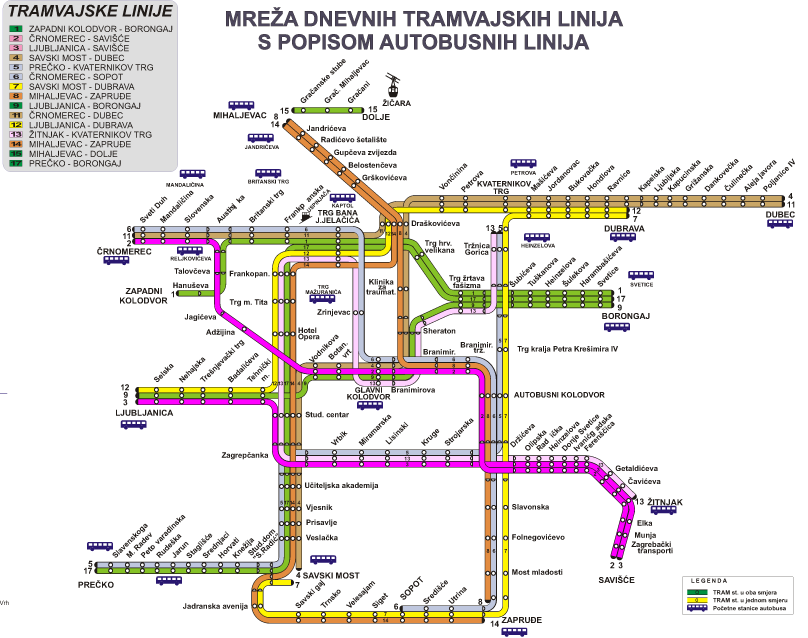 The Zagreb trams network
The Zagreb trams network
The Zagreb trams network consists of 15 lines which connect suburbs as far west from the centre as Prečko (8 kilomtres), as far east as Dubec (8 kilometres), north to Mihaljevac (3 kilometres) and south to Avenue Dubrovnik in Novi Zagreb (an additional line, running further south to Velika Gorica, servicing Zagreb Franjo Tudman airport, is planned). Throughout the night, four lines remain, connecting essential workers, night-time workers and late-night revellers (although they are sometimes replaced by night buses due to maintenance works). © Romulić & Stojčić
© Romulić & Stojčić
The completion of the line to Prečko catalysed the expansion of the westerly-lying suburbs of Špansko and Prečko. The change visited upon the rest of the city by the Zagreb trams network has been no less fundamental. Certainly, at weekends, Zagreb can confidently claim to be a 24-hour city because of its trams. Day or night, no place within the city suburbs is too far to reach because of Zagreb trams.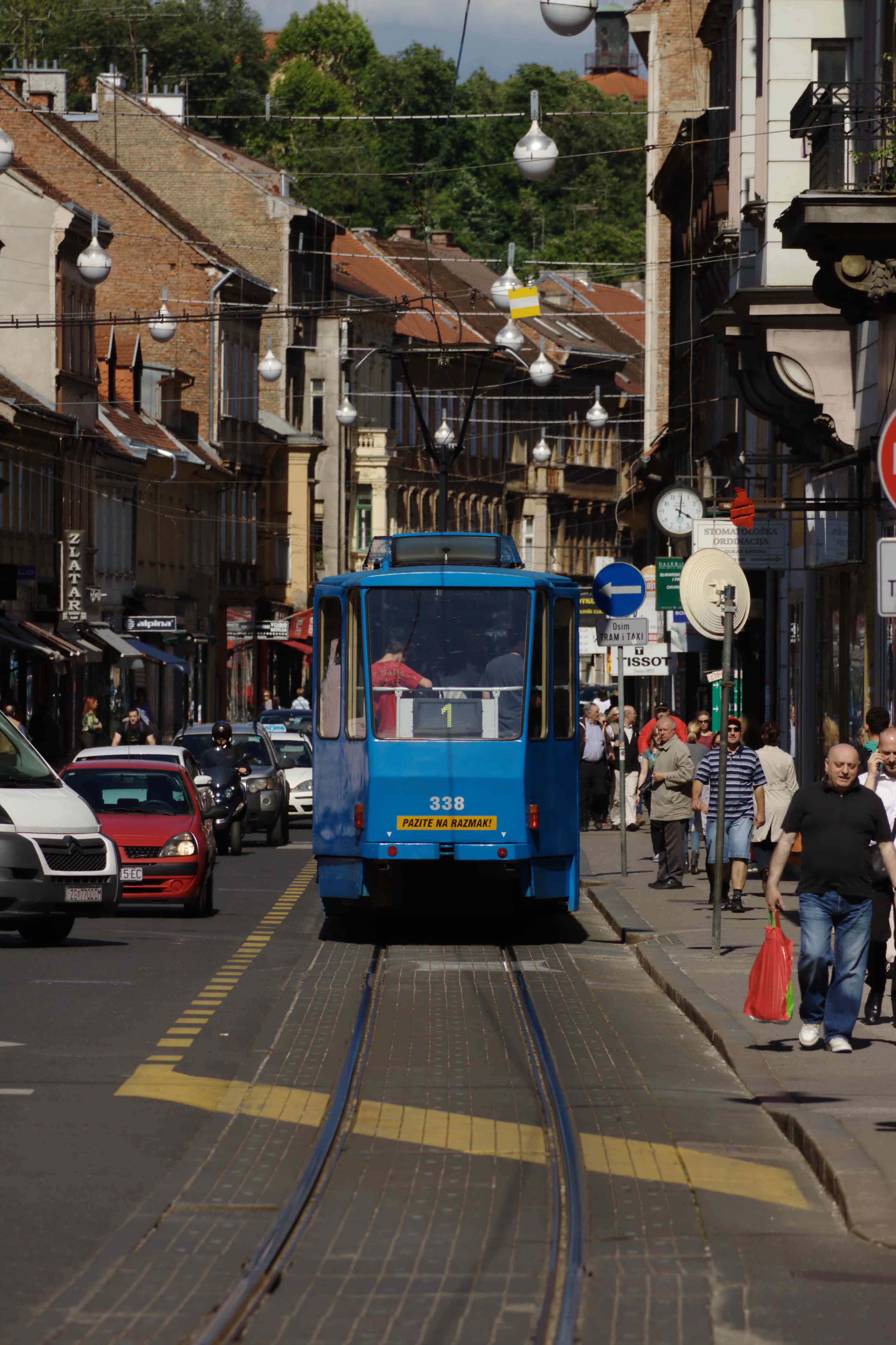 © Aktron / Wikimedia Commons
© Aktron / Wikimedia Commons
So reliable and well used are Zagreb trams that it's perhaps understandable why they are sometimes taken for granted. Whole generations now living in the city do not even know a Zagreb without a tram network. Its importance to all was put into sharp focus during the early part of 2020 when the Zagreb trams network was temporarily closed in response to the COVID-19 pandemic. Perhaps only then was the true scale of integration between Zagreb trams and the lives of city residents truly recognised. 'You don't know what you've got 'til it's gone.'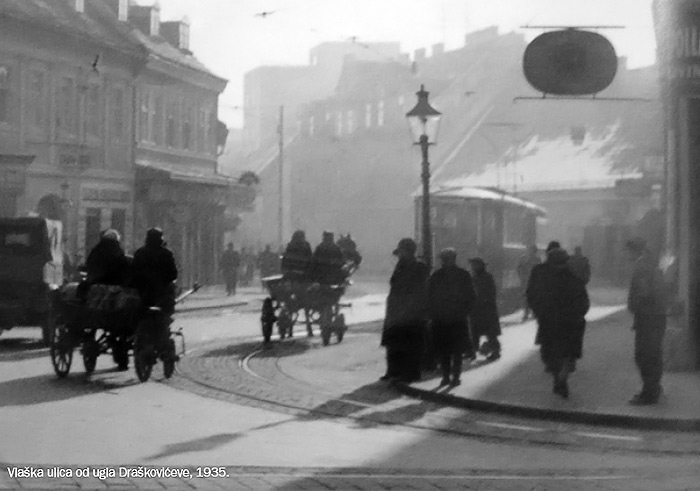 Zagreb trams on the corner of Vlaška and Draškovićeva streets in 1935 © Public domain
Zagreb trams on the corner of Vlaška and Draškovićeva streets in 1935 © Public domain
Lest we forget to give credit where credit is due, here are some interesting facts about Zagreb trams.
The Zagreb trams network was started in 1891 with the opening of the first line. Back then, the trams were pulled by horses - the electric tram didn't debut in Zagreb until 1910. The first journey started at the site of today's Technical Museum and the first track ran for some 8-kilometres. So fascinated were Zagreb residents with the introduction that some 20, 000 passenger journeys were made on the second day. The population of Zagreb at the time was 40, 000.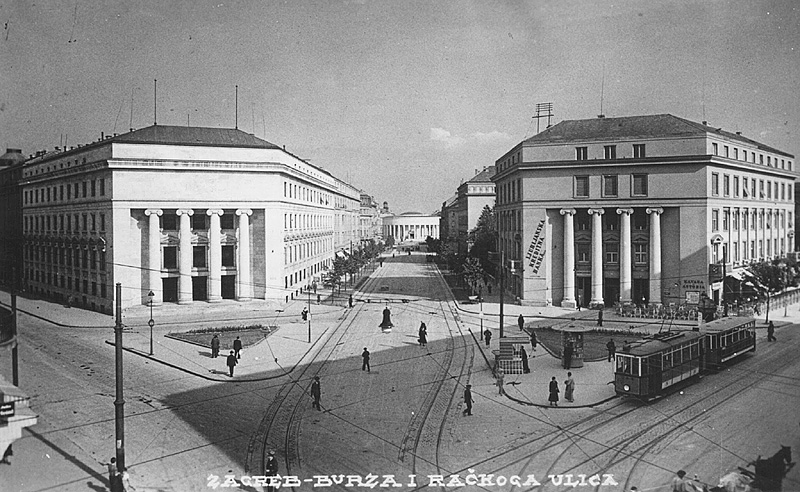 The route from Draškovićeva to Džamija in the 1930s © HappyV
The route from Draškovićeva to Džamija in the 1930s © HappyV
Osijek in Slavonia, east Croatia, was the first city in the country to have trams. The first international railway line into Croatia was built to facilitate holidays on the Kvarner coast, but the rail line ended in Rijeka. The upper echelons of Austro-Hungarian society who took this train were transported to their preferred destination – Opatija – by tram.
The most-modern low floor trams that now run in Zagreb were introduced in 2005.
There are two separate tram stations in Zagreb which have the same name – there are Heinzelova stations on the lines both to Savišće and Borongaj.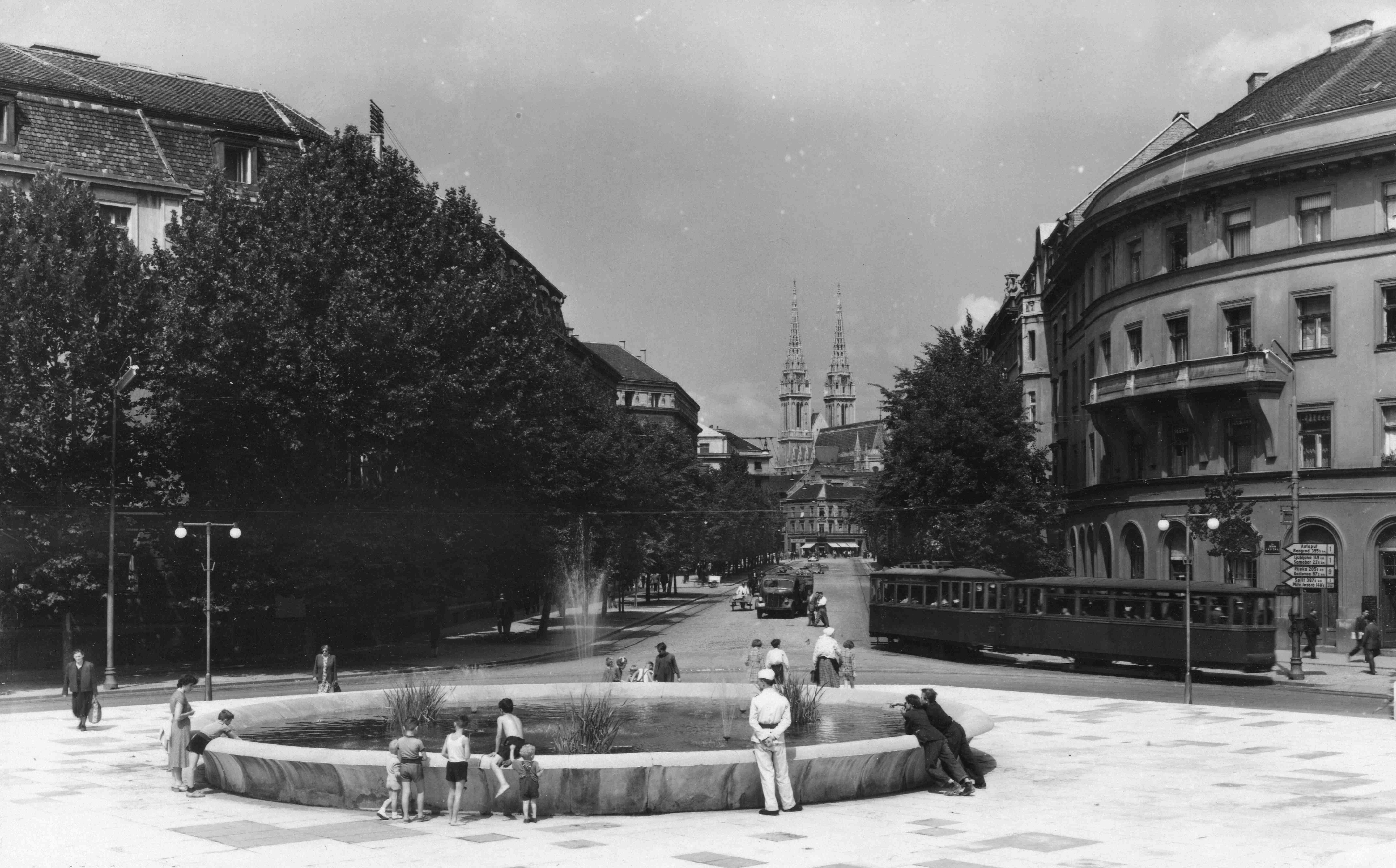 The view from Džamija up to Draškovićeva and the cathedral in 1947 © Romák Éva
The view from Džamija up to Draškovićeva and the cathedral in 1947 © Romák Éva
The Zagreb trams network has 116.3 kilometres (72.3 miles) of metre gauge track. It is the same track all over the city, except for the line which runs north to Mihaljevac, which is unique. This line is both the fastest and the shortest in the Zagreb trams network. It services some of the most desirable Zagreb suburbs in which to live. But, of course. The inclusion of the Mihaljevac line brings the track total to 120 kilometres.
Children under the age of six do not require a ticket to ride on Zagreb trams.
There are six different types of tram currently running on the network. Zagreb residents have given nicknames to different models over the years – Đuro was named after a factory that made it, Bik, meaning bull, got its name because it was stronger than older models, Čeh was named after Czechoslovakia, the country where it was produced, Katica, Genšer and Zeko meaning bunny. Everyone likes the most modern trams in summer, because they have air conditioning but, in winter, city residents greet with joy the approach of older models on their route – the seats are heated to a toasty temperature.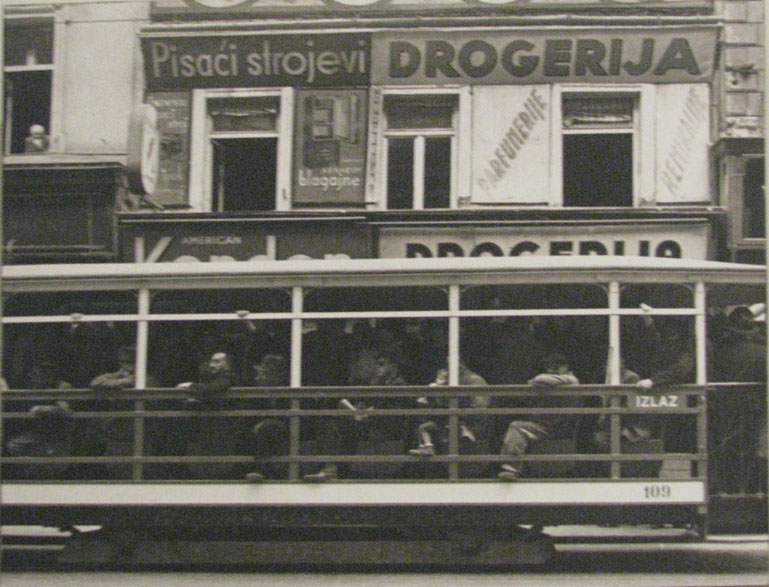 A photograph of how the open carriages of Zagreb trams used to look. The original of this photograph can be found in © Zagreb City Museum
A photograph of how the open carriages of Zagreb trams used to look. The original of this photograph can be found in © Zagreb City Museum
The longest single direction journey you can make on Zagreb trams is between Prečko in the west of the city and Dubec in the east. The journey takes around 76 minutes. You have to change tram only once to make this journey.
Apart from being the most environmentally friendly motorised public transport option in the city, the trams have massively contributed to Zagreb being a modern eco-friendly capital. Many city tram networks run down the middle of roads. While some lines in Zagreb are also placed here, many instead run at the sides of roads. This positioning – plus the way the lines sit in the road – make them problematic for cyclists. And this is partially the reason why Zagreb has 220 kilometres of dedicated cycle paths which exist not on the roads, like in other cities, but on the pavements.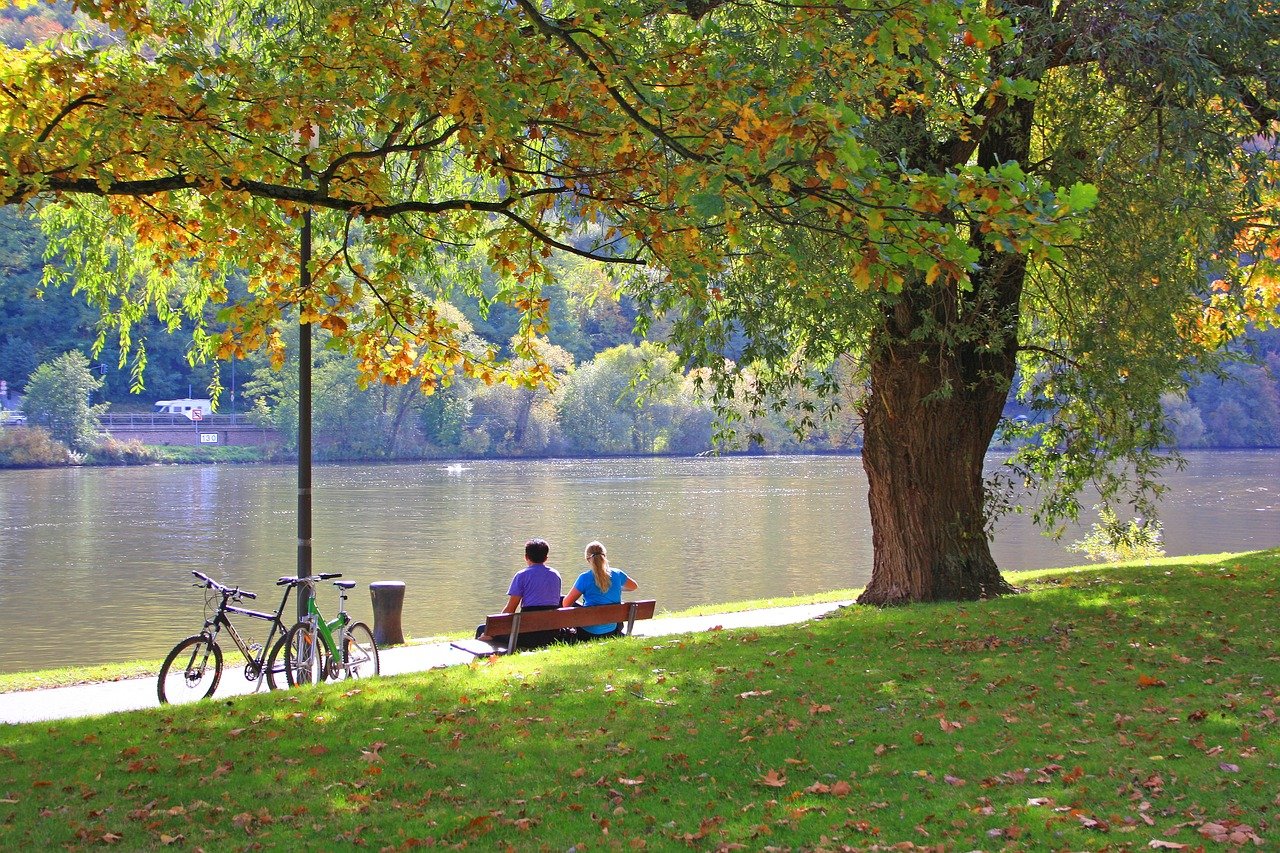 Zagreb's generous 220 kilometres of dedicated cycle paths come partially as a result of the positioning and construction materials of the Zagreb trams network © G Schneider
Zagreb's generous 220 kilometres of dedicated cycle paths come partially as a result of the positioning and construction materials of the Zagreb trams network © G Schneider
One of the world's worst tram accidents happened in 1954 on the Zagreb network. The tragedy took place on the old, steep stretch running near Mirogoj cemetery. Nineteen passengers were killed and thirty seven were severely injured.
During the day, each line runs on average every 5–10 minutes. Almost all stations on the Zagreb tram network sit on at least two lines.
Zagreb's tram network transported 204 million passengers in 2008.
A few years ago, the lowest fare tram ticket was 10 kuna. Zagreb trams were then often ridden by people without a ticket (and still are). The company who runs the tram network, ZET, decided to decrease the price of the lowest ticket to 4 kuna. Since doing so, many more people buy a ticket for Zagreb trams. You can travel for 30 minutes on any tram or trams with a 4 kuna ticket.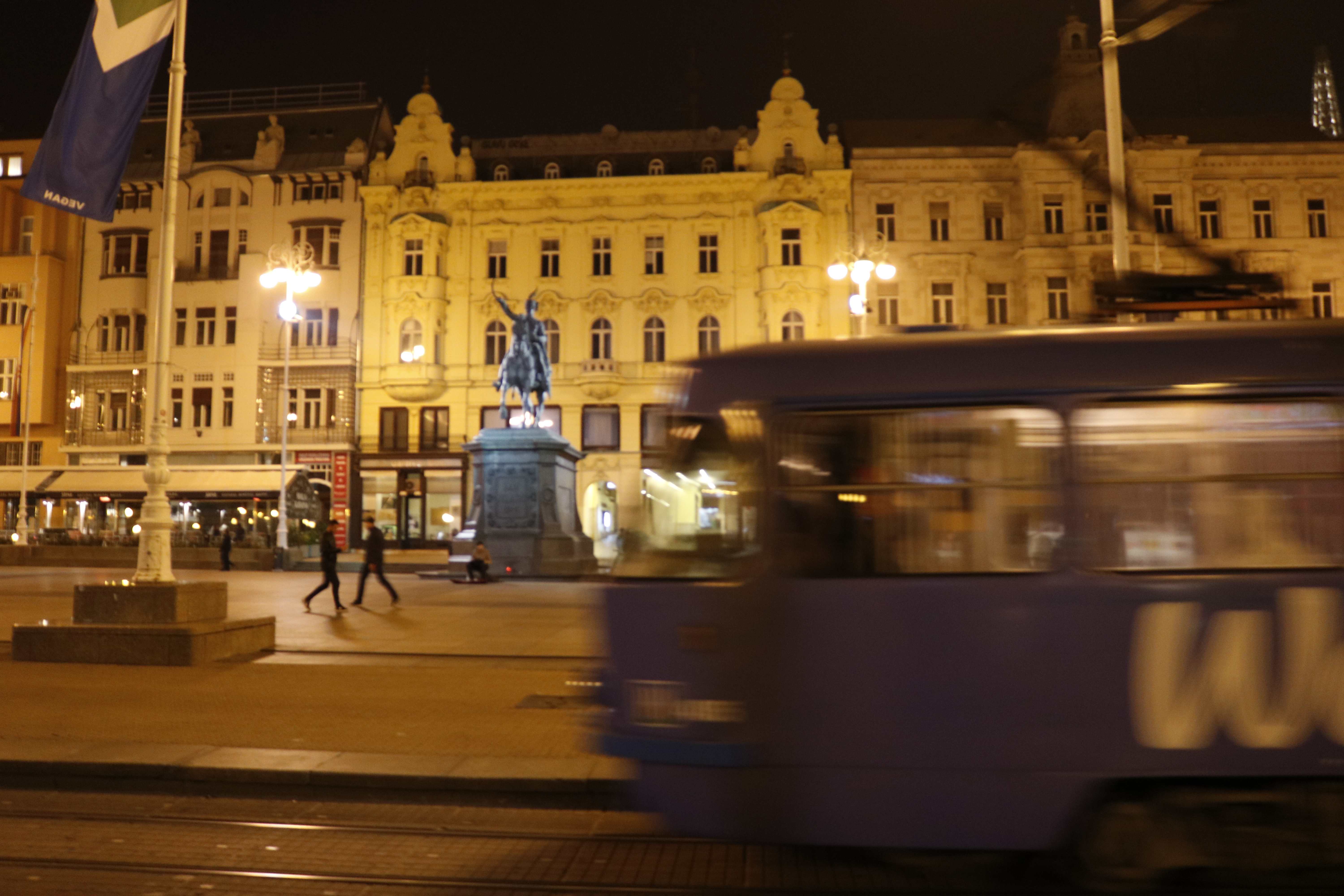 © Marc Rowlands
© Marc Rowlands
All uncredited photographs courtesy © ZET
ZET: Zagreb Trams Operating Along Ilica, Ban Jelacic Square Again
The Zagreb earthquake which struck back in March this year caused a huge amount of disruption in the Croatian capital and the tram lines were far from immune to it. Thankfully, as of today, all of ZET's trams will be running as normal once again, operating along Zagreb's most famous street (Ilica) and passing Ban Jelacic Square, which wasn't possible for several months.
As Poslovni Dnevnik writes on the 2nd of July, 2020, all of ZET's tram lines will run according to the valid summer timetable as of today, the 2nd of July, 2020.
After the expert services performed detailed inspections and eliminated the dangers that threatened the lines after the earthquake, and the ZET teams checked the correctness of the tram tracks and the accompanying voltage network, the city's trams will begin running along Jurisiceva, Ilica, Praska and past Ban Jelacic Square again today, ZET reported.
''As of today, all of the tram lines that operated on the altered routes are returning to their usual routes,'' ZET's statement reads.
ZET reports that line 13 (Kvaternikov trg - Zitnjak) is returning to operations, while at the same time the extraordinary bus lines 608 (Trg zrtava fasizma - Vlaska - Kvaternikov trg) and 611 (Glavni kolodvor - Praska) will end.
The final works on the regular maintenance of the tram tracks in the central square are still in progress, but they will no longer affect the use of the tram lines in those areas, which was the case since the earthquake struck earlier this year.
"On this occasion, we once again call on passengers to abide by the Decision of the National Civil Protection Headquarters on the obligation to wear a medical mask or face mask when using public transport, and ZET will, as before, disinfect the vehicles three times a day and ventilate them to reduce the possibility of spreading the coronavirus infection,'' they state from ZET.
For more on public transport in Zagreb and beyond, follow our travel page.
New Changes to Zagreb Public Transport: ZET Tram's New Timetable
The coronavirus pandemic saw numerous stringent measures introduced in Croatia, and now comes the second phase of loosening them gradually. While buses are in operation, only a select few trams in Zagreb have been. ZET made the decision to slow the return to normal for the trams owing not only to the need to be careful in the handling of coronavirus, but because of the damage caused by the Zagreb earthquake.
As Poslovni Dnevnik writes on the 4th of May, 2020, in the second phase of the gradual re-normalisation of ZET's tram transportation, tram line 12 will be put back into service as of today, Monday, May the 4th, and line 5 will return to its usual route, ZET announced on Sunday.
Line 12 will operate on the modified route: Ljubljanica - Ulica Grada Vukovara - Držićeva - Šubićeva - Kvaternikov Square - Maksimirska - Dubrava. At the same time, tram line 5 will operate along its usual route from Monday, Prečko - Savska cesta - Ulica Grada Vukovara - Držićeva - Šubićeva - Kvaternikov Square - Maksimirska - Dubrava.
The statement recalls that as of the end of last month, more precisely April the 27th, tram line 3 has been running along the Ljubljanica - Ulica Grada Vukovara - Savišće route, while line 14 has been running from Zapruđe via the Remetinec roundabout to Ljubljanica.
ZET tram lines will continue to operate according to a customised schedule and more detailed information on the routes, lines, tram numbers and the current schedule, as well as any changes when they come in will be available on ZET's official website.
"ZET's expert services, in cooperation with other emergency services, are on the ground every day and are working intensively to ensure that tram traffic and other lines continue to be gradually established," a statement from ZET said.
Make sure to follow our travel page for more. If it's just the Croatian capital you're interested in, give Total Zagreb a follow.


